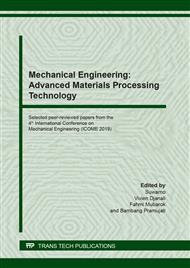[1]
H. Zhao, J. Humbeeck, J. Sohier, I. De Scheerder, Electrochemical polishing of 316L stainless steel slotted tube coronary stents, 2002. https://doi.org/10.1023/A:1019831808503.
Google Scholar
[2]
T. Hryniewicz, R. Rokicki, K. Rokosz, Surface characterization of AISI 316L biomaterials obtained by electropolishing in a magnetic field, 2008. https://doi.org/10.1016/j.surfcoat. 2007.07.067.
DOI: 10.1016/j.surfcoat.2007.07.067
Google Scholar
[3]
T. Mizuno, H. Mulki, Changes in surface texture of zinc-coated steel sheets under plastic deformation, 198 (1996) 176–184.
DOI: 10.1016/0043-1648(96)06963-3
Google Scholar
[4]
A. Syaifudin, R. Takeda, K. Sasaki, Effect of balloon shape in treatment of eccentric plaque considering the changes in stent surface roughness, in: Proc. Mech. Eng. Congr., 2014. https://doi.org/10.1299/jsmemecj.2014._S0220204-.
DOI: 10.1299/jsmemecj.2014._s0220204-
Google Scholar
[5]
A. Syaifudin, R. Takeda, K. Sasaki, Effects of plaque lengths on stent surface roughness, Biomed. Mater. Eng. 25 (2015) 189–202. https://doi.org/10.3233/BME-151269.
DOI: 10.3233/bme-151269
Google Scholar
[6]
A. Syaifudin, K. Sasaki, FEM analysis on balloon expandable stent considering viscoplasticity, (2018) 30022. https://doi.org/10.1063/1.5046257.
DOI: 10.1063/1.5046257
Google Scholar
[7]
A. Syaifudin, R. Takeda, K. Sasaki, Development of asymmetric stent for treatment of eccentric plaque, Biomed. Mater. Eng. 29 (2018) 299–317. https://doi.org/10.3233/BME-181737.
DOI: 10.3233/bme-181737
Google Scholar
[8]
A. Syaifudin, J.B. Ariatedja, Y. Kaelani, R. Takeda, K. Sasaki, Vulnerability analysis on the interaction between Asymmetric stent and arterial layer, Biomed. Mater. Eng. 30 (2019) 309–322. https://doi.org/10.3233/BME-191054.
DOI: 10.3233/bme-191054
Google Scholar
[9]
C.M. Wichern, B.C. De Cooman, C.J. Van Tyne, Surface roughness changes on a hot-dipped galvanized sheet steel during deformation at low strain levels, Acta Mater. 52 (2004) 1211–1222. https://doi.org/https://doi.org/10.1016/j.actamat.2003.11.005.
DOI: 10.1016/j.actamat.2003.11.005
Google Scholar
[10]
H.A. Al-Qureshi, A.N. Klein, M.C. Fredel, Grain size and surface roughness effect on the instability strains in sheet metal stretching, J. Mater. Process. Technol. 170 (2005) 204–210. https://doi.org/https://doi.org/10.1016/j.jmatprotec.2005.04.116.
DOI: 10.1016/j.jmatprotec.2005.04.116
Google Scholar
[11]
O. Wouters, W.P. Vellinga, R. Van Tijum, J.T.M. de Hosson, On the evolution of surface roughness during deformation of polycrystalline aluminum alloys, Acta Mater. 53 (2005) 4043–4050. https://doi.org/https://doi.org/10.1016/j.actamat.2005.05.007.
DOI: 10.1016/j.actamat.2005.05.007
Google Scholar
[12]
P. Poncin, C. Millet, J. Chevy, J. Proft, Comparing and optimizing Co-Cr tubing for stent applications, Mater Process. Med. Devices Conf. (2004) 25–27.
Google Scholar
[13]
P. Poncin, Stent Tubing: Understanding the Desired Attributes, in: Mater. Process. Med. Devices, 2003. http://www.minitubes.com/wp-content/uploads/2016/04/Stent-Tubing-Understanding-the-Desired-Attributes-.pdf (accessed July 13, 2019).
Google Scholar
[14]
J. Jung, S. Jun, H.-S. Lee, B.-M. Kim, M.-G. Lee, J. Kim, Anisotropic Hardening Behaviour and Springback of Advanced High-Strength Steels, Metals (Basel). 7 (2017) 480. https://doi.org/10.3390/met7110480.
DOI: 10.3390/met7110480
Google Scholar
[15]
K. Li, J. Peng, J. Peng, Mechanical Behavior of 316L Stainless Steel after Strain Hardening, MATEC Web Conf. 114 (2017) 02003. https://doi.org/10.1051/matecconf/201711402003.
DOI: 10.1051/matecconf/201711402003
Google Scholar
[16]
F. Qayyum, M. Shah, A. Muqeet, J. Afzal, The effect of anisotropy on the intermediate and final form in deep drawing of SS304L, with high draw ratios: Experimentation and numerical simulation, IOP Conf. Ser. Mater. Sci. Eng. 146 (2016). https://doi.org/10.1088/1757-899X/146/1/012031.
DOI: 10.1088/1757-899x/146/1/012031
Google Scholar
[17]
R. Padmanabhan, A.J. Baptista, M.C. Oliveira, L.F. Menezes, Effect of anisotropy on the deep-drawing of mild steel and dual-phase steel tailor-welded blanks, J. Mater. Process. Technol. 184 (2007) 288–293. https://doi.org/10.1016/j.jmatprotec.2006.11.051.
DOI: 10.1016/j.jmatprotec.2006.11.051
Google Scholar
[18]
T. Trzepiecinski, H.G. Lemu, Study of material anisotropy in metal forming using finite element methods, Anisotropy Res. New Dev. (2012).
Google Scholar
[19]
ASTM International, Standard Test Methods for Tension Testing of Metallic Materials, in: ASTM E8-13, 2013. https://doi.org/10.1520/E0008.
Google Scholar
[20]
Japanese Industrial Standard, Test pieces for tensile test for metallic materials, in: JIS Z 2201, (1998).
Google Scholar
[21]
A. Syaifudin, Deformation Analysis of Balloon-Expandable Stents Considering Its Surface Roughness and Viscoplasticity, 2013. https://www.eng.hokudai.ac.jp/e3/alumni/files/abstract/ m192.pdf.
Google Scholar
[22]
W. Ghennai, O. Boussaid, H. Bendjama, B. Haddag, M. Nouari, Experimental and numerical study of DC04 sheet metal behaviour-plastic anisotropy identification and application to deep drawing, (n.d.). https://doi.org/10.1007/s00170-018-2700-8.
DOI: 10.1007/s00170-018-2700-8
Google Scholar
[23]
Z.E. Gellér, K. Albrecht, J. Dobránszky, Electropolishing of Coronary Stents, Mater. Sci. Forum. 589 (2009) 367–372. https://doi.org/10.4028/www.scientific.net/msf.589.367.
DOI: 10.4028/www.scientific.net/msf.589.367
Google Scholar
[24]
P. Sojitra, C. Engineer, D. Kothwala, A. Raval, H. Kotadia, G. Mehta, Electropolishing of 316LVM stainless steel cardiovascular stents: An investigation of material removal, surface roughness and corrosion behaviour, Trends Biomater. Artif. Organs. 23 (2010) 115–121.
Google Scholar
[25]
R. Amaral, P. Teixeira, E. Azinpour, A.D. Santos, J. Cesar De Sa, Evaluation of ductile failure models in Sheet Metal Forming, (n.d.). https://pdfs.semanticscholar.org/757b/f58c67192b160dec06fb0f3a667ffdb0b491.pdf?_ga=2.106824579.1088945445.1566018736-697992882.1561362118 (accessed August 17, 2019).
DOI: 10.1051/matecconf/20168003004
Google Scholar
[26]
G. Çinar, Effects of Anisotropy on Formability in Sheet Metal Forming, (2006) 2–24.
Google Scholar
[27]
L.M. Weldon, P.E. Mchugh, W. Carroll, E. Costello, C. O'bradaigh, The influence of passivation and electropolishing on the performance of medical grade stainless steels in static and fatigue loading, (n.d.). https://link.springer.com/content/pdf/10.1007%2Fs10856-005-5922-x.pdf (accessed August 17, 2019).
DOI: 10.1007/s10856-005-5922-x
Google Scholar


